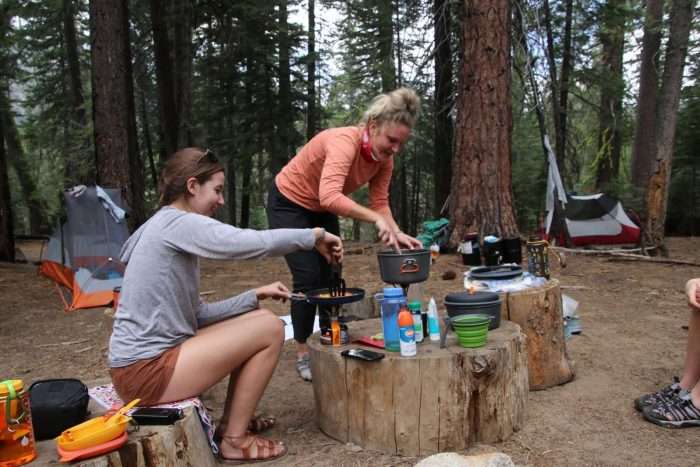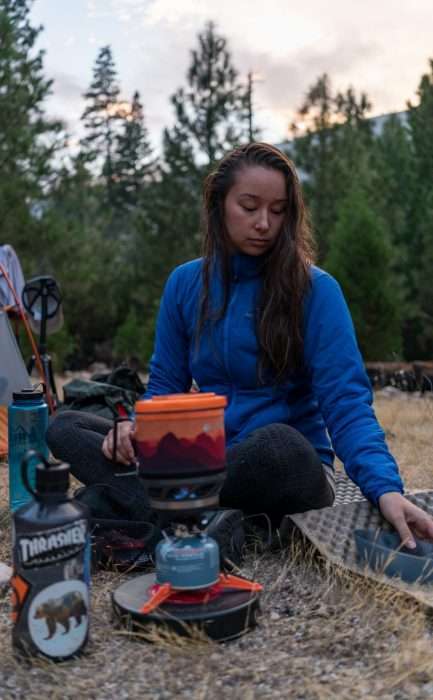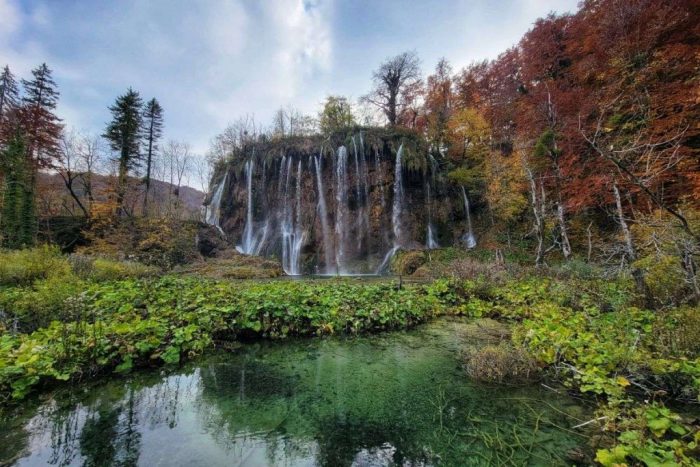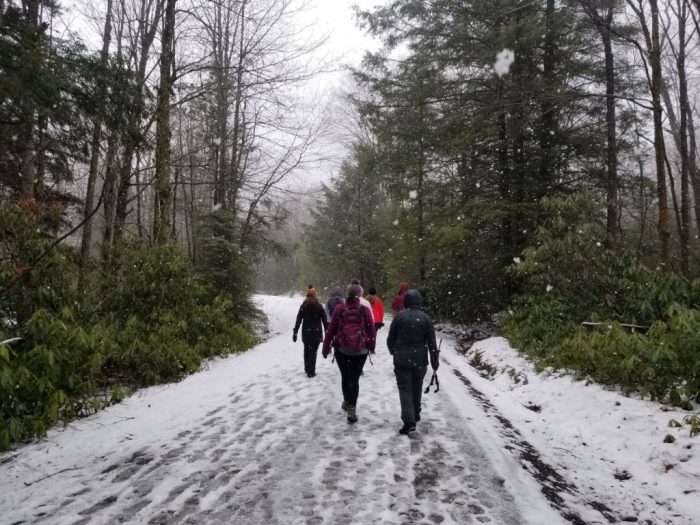Backpacking Food and Backcountry Cooking Safety
This article is a supplement to our Backpacking for Beginners Live Virtual Workshop.
You did it! You’ve hiked for miles all day. Your body is tired, but your soul is satiated. You sigh and take it all in: The birds chirping, the brook babbling…your stomach growling. Ugh. Guess there are worse ways to spoil a good shinrin-yoku moment, but the time has come to prepare and yes—enjoy a meal in the backcountry. Luckily, backpacking food and how to prepare it has come a long way since bulky stoves and canned freeze-dried beef patties. (Mmm… yummy.) Here’s how you can get your grub on in the great outdoors, even if you’re a beginner.
Filtering Water
First things first. There isn’t much you can’t do cooking-wise until you get some water. We hate to break it to you, but just because the H2O in that pretty mountain stream over there is clear and cold doesn’t mean it’s clean. “But it’s a cute, little creek in the middle of this magical forest!” you argue. Fine. Cup your hand and take nice big drink. Now please say hello to giardia or perhaps other fun parasite pals, and all the symptoms that come with them. (Don’t say we didn’t warn you.)
If you’d rather not cap off your wilderness trek in such a fun fashion, purify your water! There are a couple of different methods, each with its own pros and cons. Think about your trip and study up to determine which approach is best for you.
- boiling
- filtration system/life straw
- purifier
- UV light
- tablets (chlorine dioxide, iodine)
Also consider where you will be traveling. Some methods only filter out dirt, bacteria and parasites, while others go a step further and filter nasty extras such as water-borne viruses. Going out of the country? Do some research into what you need to look out for in which part of the world.
Trail Nutrition and Backpacking Food
You can finally forget what’s been drilled into your female brain since birth: Extra calories are not the enemy. Not on the trail. You need them, and you will use them—have no fear. So munch away!
Snacks
Some great snack options include trail mix, fruit leather, granola bars, almond butter pouches and jerky. No matter what, make sure your trail treats are durable and can stand up to extreme weather and shifting gear. (No one wants to snack on a sad and mushy poo-like brownie after a tough couple of miles in the hot sun.) While nutrients and calories are pretty easy to maintain with snacks and meals, make sure you’re getting plenty of electrolytes, too. This can either be done using common sports drink powders, energy chews, or through salty food choices such as jerky or bullion.
Meals
Dehydrated meals are pretty amazing these days thanks in part to small, female-owned backpacking food companies. Heather’s Choice, Packit Gourmet, Outdoor Herbivore, TrailDrops, Outdoor Pantry and Next Mile Meals are all owned by adventurous women who create delicious options for your trekking adventures. We’re talking stuff like African Peanut Stew, Tex Mex Breakfast Tacos, Quinoa Vegetable Soup, Cherry Vanilla Oatmeal, Yakatori Chicken with Japanese Fried Rice, and Coconut Chicken Curry. (Need we go on?) Many of these companies provide vegetarian, vegan, and gluten-free options as well. Make sure you give yourself plenty of variety. There are also tons of pie iron recipes to try and make over a campfire, so you can make pizza or cookies. As you can clearly see, there’s zero need to eat cheesy rice three nights in a row. It’s a boost to your morale and mental state to have something new to look forward to each time you break for a meal.
Just for fun, here’s one of our favorite backcountry-cooking recipes we sometimes make over the campfire during our Red River Gorge Hiking and Backpacking Workshop.
Fire-Roasted Beef Jerky Chili
Ingredients:
- 1/4 cup dehydrated onion (or 1/2 fresh, chopped)
- 1/2 cup dehydrated green pepper (or one fresh, chopped)
- 1 (16 ounce) can chili beans
- 1 (14.5 ounce) can diced tomatoes (with chilis for an extra kick)
- 1 (8 ounce) can tomato sauce
- 1 packet taco seasoning
- 1 (3.25 ounce) bag beef jerky, chopped or torn
- 1 1/2 cans of water
- olive oil (if using fresh vegetables)
Directions:
- Build a hot campfire with a sizable amount of hot coals. Construct fire on one side of fire pit, leaving enough room to place your heat-proof cook pot (stainless steel, cast iron, etc). Push hot coals to other side of fire pit to create your “burner.”
- If using fresh veggies, heat olive oil in pot. Then sautè peppers and onions until tender.
- Add rest of ingredients to pot. Simmer for 25 minutes or longer, until heated through and flavors distribute.
- Feed “burner” as needed with fresh, hot coals.
Cooking Backpacking Food on a Stove System
Your water’s clean. Your food’s unpacked. You’re ready to cook. You think. Maybe. (You eye the gas canister with trepidation.) Yes, the thought fire in general may be a bit intimidating. Please know it’s totally okay to be a little freaked about lighting the gas for the first time. But it’s either conquer that fear, or eat trail mix your entire trip. First, let’s talk about some of the different camping stove setups. Again, do some research and think about your trip and the climate and conditions of your destination.
- Wood stoves: Used by those wanting to avoid the bulk of carrying fuel canisters. Planning concerns include wood availability, humidity, regulations which may prohibit open fires.
- Liquid fuel stoves (kerosene or white gas): Used by those who are concerned about fuel availability, and know they will be camping in adverse conditions like high altitudes, or extreme low temperatures.
- Gas canister stoves: Usually the most lightweight, and have the best flame control of all the stove setups. Though some are not as reliable or efficient below freezing, they are much easier to use and control than liquid fuel or wood stoves.
To light a gas canister stove system (the one we use most often), follow these steps:
- Connect the gas canister to the stove top
- Pump the gas using the pump on the canister
- Open the gas line
- Light the fuel in the catchment area of the stove top
Now you’re cooking with gas, baby! (Literally!) Pour your now-boiling water in the meal bag and let it sit for the specified time. (Ugh, we know! The waiting is the worst!) Finally—sit back and enjoy a hot meal while streaming a little hippy TV. Tonight’s feature? Mountain views with sunset hues.
Related: Creating the Ultimate Campfire Cooking Kit
Backpacking Food Storage and Large Predator Safety
After meal clean-up, there’s one final step we need to discuss before you hit the hay. (Er, nylon.) Wildlife. Yep, it’s out there. First, it’s important to realize bear attacks and snake bites are extremely rare overall. If you do happen to encounter either, back away as slowly and quietly as possible. Here are some other general guidelines you can follow to avoid encounters:
- Do not camp near water sources. Wild animals of all kinds are nocturnal and journey to the water at night. If you’re camped right next to the stream, you run a higher risk of an encounter.
- Always store food off the ground and away from your camp. Here’s a great video explaining how to hang a bear bag—the perfect solution to getting food off the ground and away from your camp.
- Use unscented toiletry products where possible. Maybe it’s best not to walk around in the wilderness smelling like a delicious vanilla cupcake. Just saying.
- Never, ever feed wildlife! Please, please do not do this. Not only are you disrupting the environment, you’re endangering the animals.
There you have it! The basics of backpacking food, water filtration, and some backcountry safety tips. We can’t wait to see you on one of our women-only backpacking or hiking trips! In the meantime, go get cookin’ good lookin’!
Related Articles
How to Start Backpacking by Preparing for Your Trip
How to Layer for Your Winter Hike
The 10 Essential Items to Pack for Every Hike
Creating the Ultimate Campfire Cooking Kit










